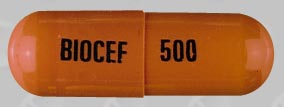Biocef and Alcohol/Food Interactions
There is 1 alcohol/food/lifestyle interaction with Biocef (cephalexin).
Cephalexin Multivitamins With Minerals
Moderate Drug Interaction
ADJUST DOSING INTERVAL: Oral products containing zinc such as mineral supplements and multivitamins may interfere with the gastrointestinal absorption of cephalexin, ceftibuten or cephradine. In one pharmacokinetic study (n=12), concurrent administration of zinc sulfate (250 mg, single oral dose) and cephalexin (500 mg, single oral dose) decreased cephalexin maximum concentration (Cmax) and systemic exposure (AUC; 0-inf) by 31.05% and 27.4%, respectively. However, in the same study, when zinc sulfate was administered 3 hours after the cephalexin dose, no significant alteration in cephalexin pharmacokinetics were observed.
MANAGEMENT: Oral medications or mineral supplements that contain zinc are recommended to be administered at least 3 hours after the cephalexin, ceftibuten or cephradine dose.
References (3)
- Ding Y, Jia Y, Li F, et al. (2011) "The Effect of Staggered Administration of Zinc Sulfate on the Pharmacokinetics of Oral Cephalexin*" Br J Clin Pharmacol, 73, p. 422-7
- World Health Organization (2020) WHO Public Assessment Reports (WHOPARs) https://extranet.who.int/pqweb/medicines/prequalification-reports/whopars
- Okamura M, Terada t, KatsuraT, Saito H, Inui K (2003) "Inhibitory effect of zinc on PEPT1-mediated transport of glycylsarcosine and beta-lactam antibiotics in human intestinal cell line Caco-2" Pharm Res, 20, p. 1389-93
Switch to consumer interaction data
Biocef drug interactions
There are 53 drug interactions with Biocef (cephalexin).
Biocef disease interactions
There are 7 disease interactions with Biocef (cephalexin) which include:
More about Biocef (cephalexin)
- Biocef consumer information
- Check interactions
- Compare alternatives
- Drug images
- Side effects
- Dosage information
- During pregnancy
- Drug class: first generation cephalosporins
- Breastfeeding
Related treatment guides
Drug Interaction Classification
| Highly clinically significant. Avoid combinations; the risk of the interaction outweighs the benefit. | |
| Moderately clinically significant. Usually avoid combinations; use it only under special circumstances. | |
| Minimally clinically significant. Minimize risk; assess risk and consider an alternative drug, take steps to circumvent the interaction risk and/or institute a monitoring plan. | |
| No interaction information available. |
See also:
Further information
Always consult your healthcare provider to ensure the information displayed on this page applies to your personal circumstances.


